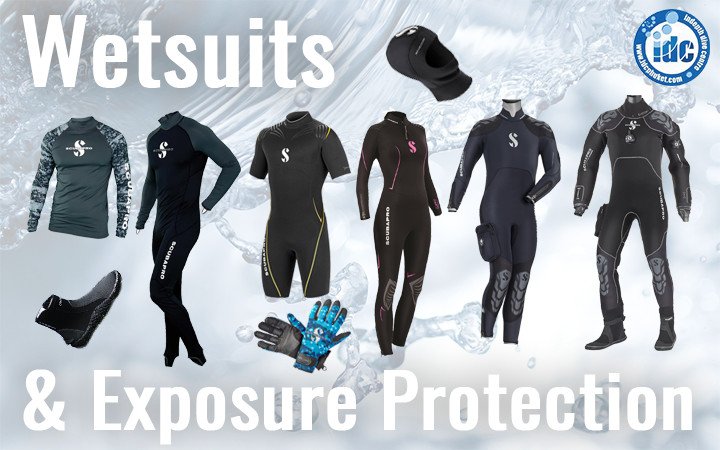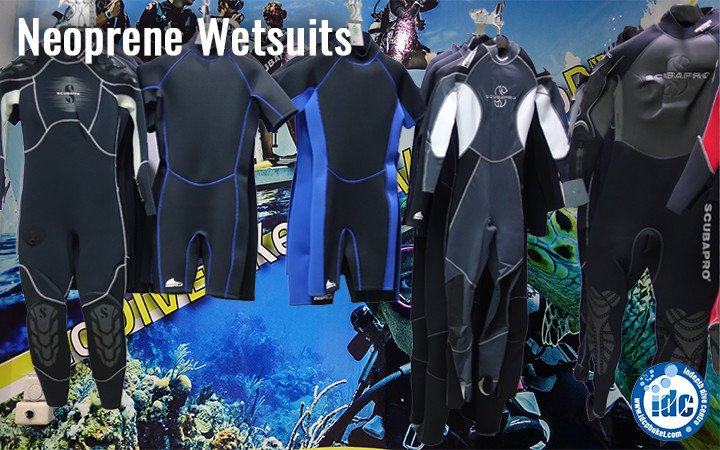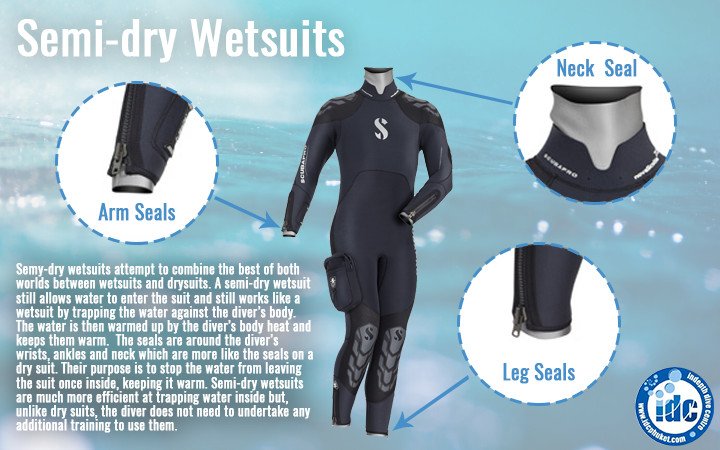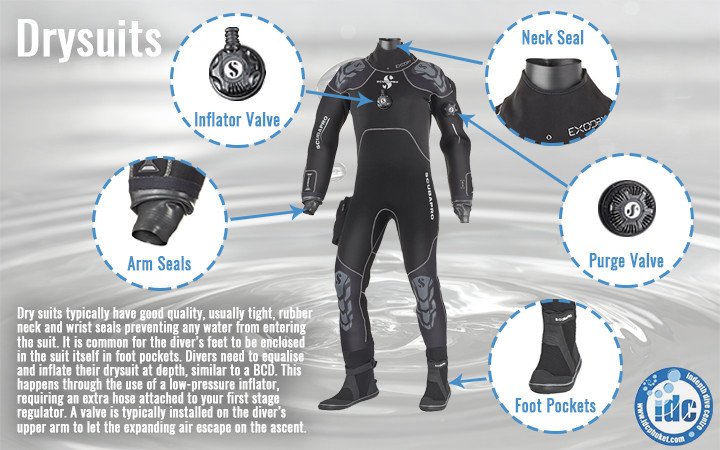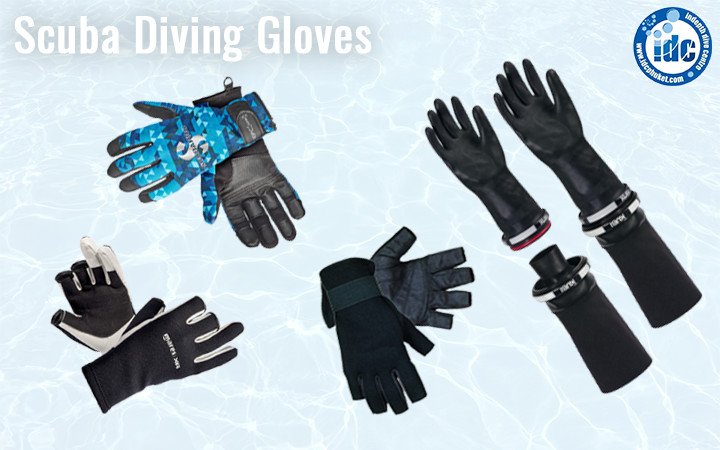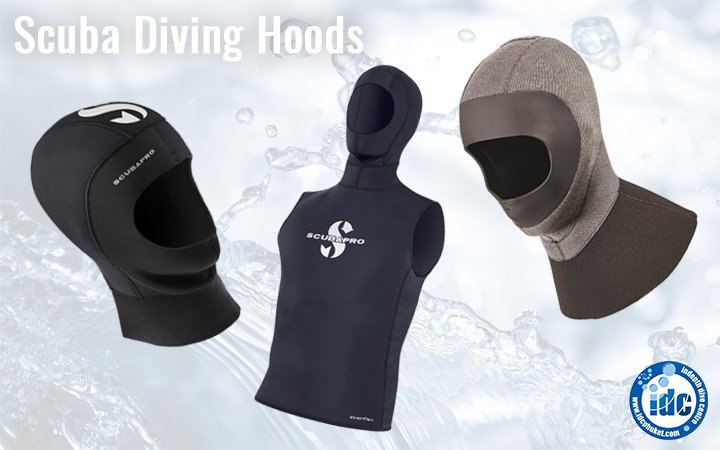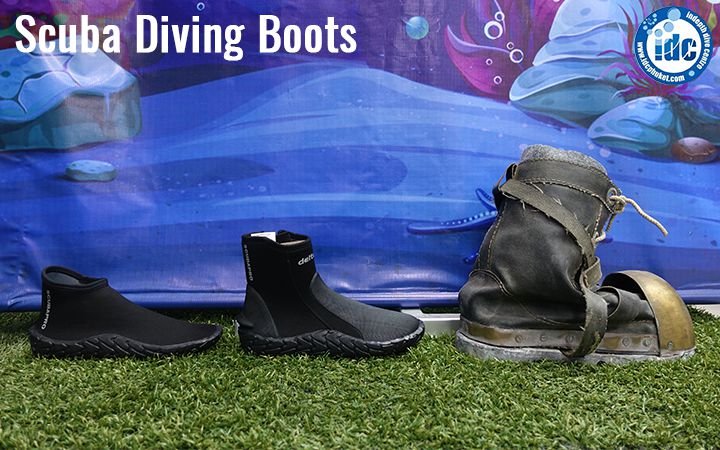Choosing a Wetsuit for Scuba Diving – Adequate Exposure Protection
If you are having a hard time choosing a wetsuit for scuba diving you are in the right place! Appropriate exposure protection which is sufficient for the local diving conditions and water temperature is critical for scuba divers. You learn on your Open Water Diver Course that water draws heat away from your body much faster than what air does, which means once you are submerged in water you will get colder faster than you otherwise would in air. Even in warm waters, over time and through a process of conduction, the water will start to cool your body. In most cases, this results in the diver feeling cold and uncomfortable which can take away from the enjoyment of the dive. In extreme cases, however, it can even result in hypothermia.
Different locations and conditions will require different levels of exposure protection in order to keep the diver warm and comfortable. Water temperature is normally the main factor to consider when choosing a wetsuit for scuba diving. Likewise, some divers feel the cold much more than others so may require more protection.
In this blog, we’ll have a look at the different kinds of exposure protection available and provide some guidance on when and where each type might be appropriate however this is not exhaustive. If you have any questions about a particular piece of exposure protection you are using or thinking about buying, please contact us here and we’ll be happy to assist. Likewise, if you are thinking about making some dives here in Thailand, we’re more than happy to recommend what exposure protection you will need for the dives you are doing and if you rent equipment from us, we’ll even include an appropriate wetsuit for you.
Skinsuits and Rash Guards
A rash guard or “rashie” is a spandex, tight-fitting, long-sleeved shirt commonly worn over a bare chest by men and over a swimsuit by women. A skinsuit on the other hand is the full-body equivalent which covers the diver’s arms and legs. Skinsuits can come in either two-piece options; whereby the leggings are separate to the rash guard, or in a one-piece model which usually zips up. Both rash guards and skin suits offer a limited amount of thermal protection. As such, they are appropriate for use in warm, tropical climates.
One advantage of rash guards and skinsuits is that they provide UV protection from the sun. Many divers choose to wear them with board shorts or underneath a ‘short’ wetsuit protecting the skin on their arms and legs from the sun. It is also common for divers to wear rash guards and skin suits underneath full wetsuits to add an extra layer for warmth but also to make the wetsuit more comfortable by adding a layer of protection between the neoprene and the diver’s skin. Rash guards and skin suits vary in price, depending on the brand but are generally cheaper than wetsuits.
Neoprene Wetsuits – Choosing a Wetsuit for Scuba Diving
The most common type of exposure protection used by divers is the wetsuit. Wetsuits are commonly made from neoprene material which is available in different thicknesses. Neoprene contains small bubbles of gas inside the material which help to reduce the conduction of heat through it. These bubbles of gas also provide buoyancy so the thicker the neoprene used in the wetsuit, the bigger the gas bubbles in it and the more buoyant it will be. For new divers acquiring new equipment, we recommend you undertake your Peak Performance Buoyancy speciality course to adjust to your new equipment and fine-tune your weighting, trim and buoyancy control. For experienced divers changing wetsuits, we recommend performing a weight check at the start of your dive to ensure you are appropriately weighted for the buoyancy of your new wetsuit.
Different levels of thickness
Neoprene is commonly available in 1mm, 3mm, 5mm and 7mm thicknesses. In some places, you may even encounter 9mm or 10mm suits. The thicker the wetsuit, the more thermal protection it provides, allowing to dive in colder water. There are many guides out there which indicate what thickness of wetsuit you need for what temperature water however these are only guides. It’s always a good idea to check with local dive centres and divers what they use on their local dive sites and if the area is prone to thermoclines which can reduce the temperature. It is usually better to have slightly more exposure protection than what you need rather than not having enough.
How does a wetsuit work?
A wetsuit works by allowing water to enter into your suit, then trapping it inside the suit and against your body. Your body, through its natural process of conduction, warms the water trapped around it which is what keeps you warm on the dive. In order for a wetsuit to work properly, it needs to fit properly. A wetsuit which is too big will not be able to trap the water and as such, once your body heats up the water around it, that water will move out of the suit and be replaced by fresh, cold water which your body will again have to warm up. This cycle is what will eventually cool the diver’s body and make them feel cold, or even worse, hypothermic.
Most wetsuits contain a zipper at the back so the divers can easily put it on and take it off. Some models include zippers around the wrists and ankles which make removal and replacement even easier. Generally, most wetsuits don’t include any rubber neck or wrist seals or gaskets, and instead, these features are more common on semi-dry and dry suits.
Shorty wetsuits
In warmer, tropical climates it is common for divers to use the short wetsuit or “shorty”. It is usually a 3mm suit but which ends at the diver’s elbows and knees. This design of suit keeps the diver’s torso and core body warm but allows the diver’s arms and legs to still be exposed to the surrounding water. In colder climates, or for divers who feel the cold, a full wetsuit is a better option as it covers the diver’s body, as well as their arms and legs, exposing very little skin to the water.
When choosing a wetsuit for scuba diving, the most important consideration is that it is going to be fit for purpose and a suitable thickness and length for the diving you intend on doing and the temperature of that water but that it also fits correctly and is comfortable. It is also important to consider the make of the wetsuit and ensure it is of good quality and has good quality stitching. Many manufacturers will also include reinforced areas around the elbows and knees which are prone to additional wear.
Semi-Dry Wetsuits – Choosing a Wetsuit for Scuba Diving
For some divers and/or conditions, a wetsuit is not enough so they opt to use a semi-dry wetsuit. A semi-dry wetsuit is generally a wetsuit which sits on the scale of thermal protection somewhere between a 7mm neoprene wetsuit and a dry suit. It attempts to combine the best of both worlds, bringing the advantages of a wetsuit together with a dry suit. A semi-dry wetsuit still allows water to enter the suit and still works like a wetsuit in that it traps the water against the diver’s body. The water is then heated up by the diver and keeps them warm and insulated.
The main difference between a wetsuit and a semi-dry wetsuit is the seals, or gaskets. The seals are around the diver’s wrists, ankles and neck which are more like the seals on a dry suit. Their purpose is to stop the water from leaving the suit once inside, keeping it warm. The advantage of a semi-dry wetsuit is not only that it is much more efficient and effective at trapping water inside it but that, unlike dry suits, the diver does not need to undertake any additional training to use it. Semi-dry wetsuits can be more expensive than standard wetsuits because of their additional seals but are more effective at keeper the diver warm in cold waters.
Drysuits – Choosing a Wetsuit for Scuba Diving
For divers diving in water too cold to be against their body, their option is to dive with a drysuit. As the name suggests, dry suits keep the diver dry. Water does not enter the suit at all, or at least shouldn’t. Instead, a pocket of air inside the suit is what keeps the diver warm. As such, divers can wear thermal undergarments under their suits which remain dry throughout the dive.
Dry seals and buoyancy
Dry suits typically have good quality, usually tight, rubber neck and wrist seals preventing any water from entering the suit. It is common for the diver’s feet to be enclosed in the suit itself in foot pockets. A downside of these is that the diver’s feet can become more buoyant than they normally would. As such, some dry suit divers need to use ankle weights to counter this buoyancy. For more details about weighting, please check this post. Divers need to equalise and inflate their drysuit at depth, similar to a buoyancy control device. This happens through the use of a low-pressure inflator, requiring an extra hose attached to your first stage regulator. A valve is typically installed on the diver’s upper arm to let the expanding air escape on the ascent.
As a dry suit is an airspace, not only does it need to be equalised but it can affect buoyancy. As such, before you dive in a dry suit, you need to undergo additional training to learn how to use it safely.
Special considerations
The huge advantage of a dry suit is obviously that you stay warmer because you stay dry. On the other hand, there are also some downsides to consider. Dry suits are usually more expensive than wetsuits and require more care and maintenance. For example, the zippers usually need waxing prior to use whereas a wetsuit zipper needs no pre-dive maintenance. If a dry suit has a tear or a leak, it is often a dive ending event. By the contrary, if a wetsuit has a small tear it can go unnoticed and is usually not a problem.
Immersion diuresis is also a consideration for divers diving in dry suits. It is physiologically normal for divers to need to go to the bathroom once they enter the water. In a wetsuit, you can simply let go. In a dry suit, you need to work around this. As a consequence, many dry suit divers install special valves into their suits. Such valves allow them to still “go to the toilet” without allowing water to enter inside of their suit. This is obviously more challenging for women although not impossible. Another option is for divers to use adult diapers for their dives or to simply hold it. Unfortunately, the calls of nature are things you need to consider before diving in a dry suit, particularly if you plan on making long dives, possibly with decompression.
Gloves
Some divers are prone to feeling the cold in their fingers even when the water is not particularly cold. Others are actually diving in very cold water. Either way, divers may have the need to wear scuba diving gloves in certain situations. Like all other types of exposure protection, gloves vary in their styles, designs and thermal properties. Gloves are available in either full-finger or half-finger options. The full-finger option is usually optimal for regular recreational diving. Divers instead prefer the half-finger option for cave and wreck diving where the diver’s need dexterity for handling lines.
Drysuit gloves are also available. They fit into the diver’s drysuit and create a seal, extending the drysuit to encapsulate the diver’s hands. On the plus side, the diver’s hands obviously stay dry and protected by an air space. On the downside though, the gloves are typically thick and can limit the diver’s dexterity making simple tasks more challenging.
In some places, like the national parks of Thailand, gloves are prohibited because divers can be encouraged to unnecessarily touch marine life once they feel protected by their gloves. Before deciding on whether to wear gloves, you need to consider whether it is permitted in the local area, whether they are necessary, and whether you will still be able to perform the necessary skills you need to in order to dive safely. Divers wearing drysuit gloves often need to practice their diving skills wearing the gloves ensuring they can still dive safely.
Hoods
Most of our heat is lost through our heads. As such, for divers feeling the cold, a hood is a great investment. Hoods come in a variety of styles including those which are attached to vests as well as those which are stand-alone and simply tuck in underneath the neck seals of wet suits and dry suits. A hood should be snug but not too tight. For divers new to wearing hoods, they can feel a little claustrophobic, make hearing difficult, make equalisation feel different and if not adjusted correctly, can interfere with the mask seal. Usually, divers need to adjust the mask straps to comfortably fit over a hood. Hoods are generally inexpensive but do take some getting used to. They make a big difference to divers who suffer the cold and are very effective at keeping the diver warm.
Boots
For divers entering over rocky shores, wearing open-heeled fins or diving in cold water, they need to wear boots. For more detailed information about boots and the types of fins they need to be worn with, please check out our blog here. Boots not only protect the diver’s feet when walking into the dive site though, but they also keep the diver’s feet warm. They are usually made from neoprene just like a wetsuit. Boots are also available in different thicknesses, just like wetsuits. Again, the thicker the neoprene, the more buoyant it will be.
Most boots have a rigid sole which protects the diver’s feet and a zipper to allow easy removal and replacement. Some boot models also include reinforcements where the fin is in contact with the boot for extra comfort. For divers who feel the cold, there is always the option of wearing a thin neoprene sock underneath the boot, like you would with a regular shoe. This adds an extra layer of thermal protection and padding.
As with any equipment purchase, we recommend you come into the shop to try the equipment on; particularly when it comes to wetsuits. A correct fit is critical and will determine whether the suit is able to effectively keep you warm or not. Because of this, you should try a wetsuit on in the shop before buying it. If you are unable to get to us or have any questions, we are still happy to help and you can contact us.
More posts about diving equipment:
- Choosing Dive Equipment
- Choosing a Scuba Diving Mask
- All about snorkels
- Choosing the right fins
- Scuba Cylinders & Valves
- Buoyancy Control Devices (BCDs)
- How to choose a Scuba Regulator
- Breathing Gas Monitoring Devices
- Depth Monitoring Devices
- Scuba Diving Weights & Quick Release Weight Systems
- Audible Signaling Devices for Scuba Diving
- Choosing a Scuba Diving Compass



